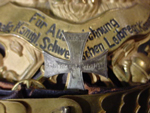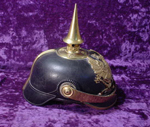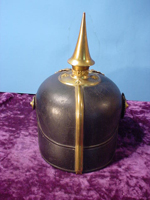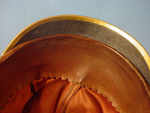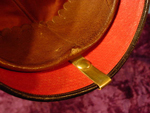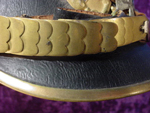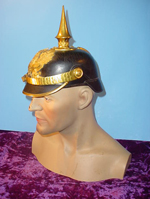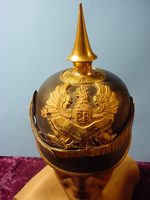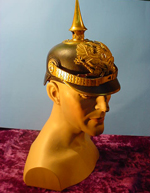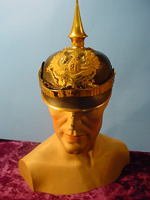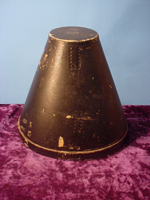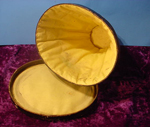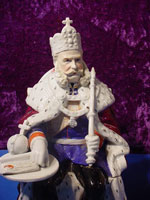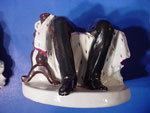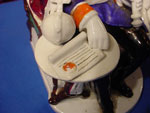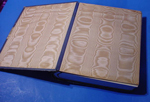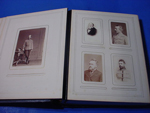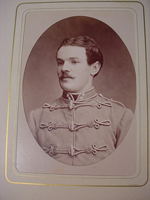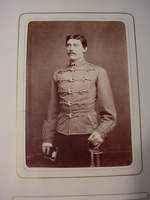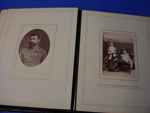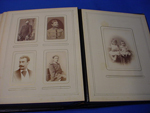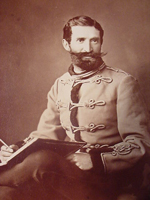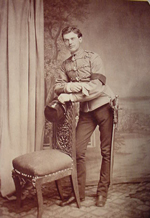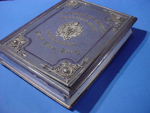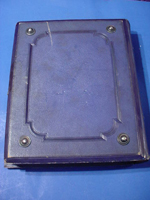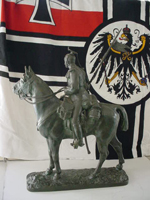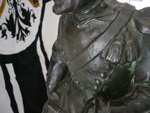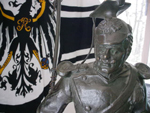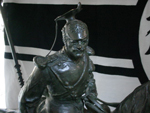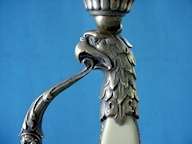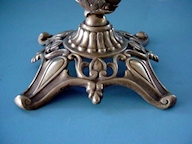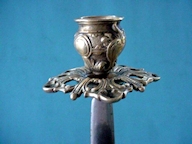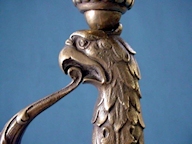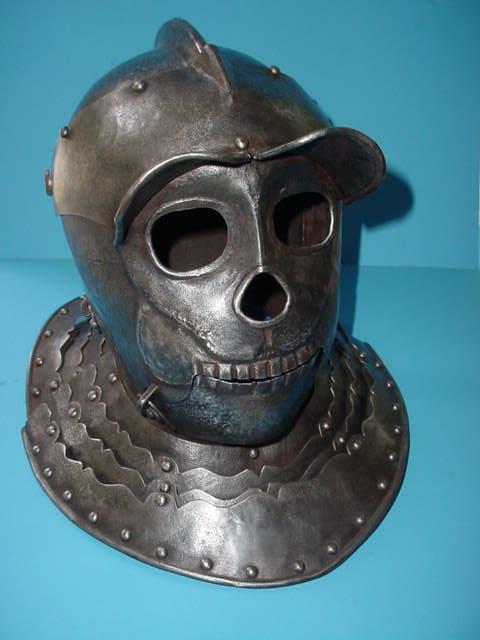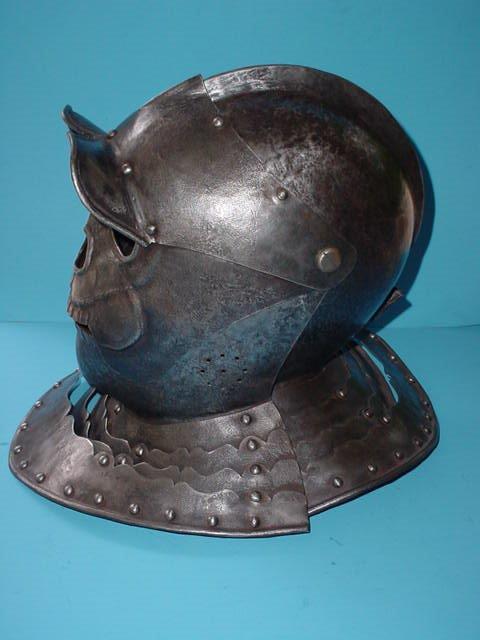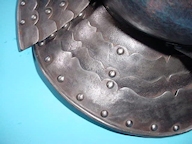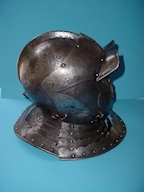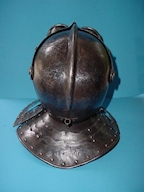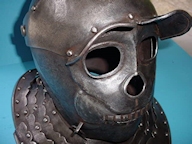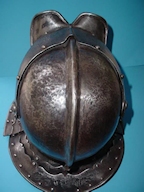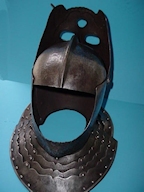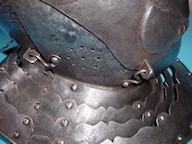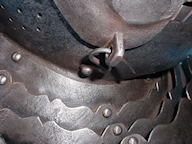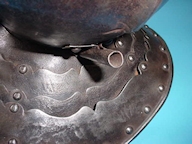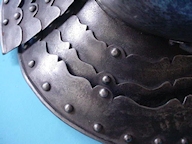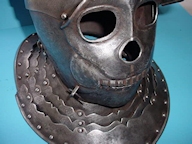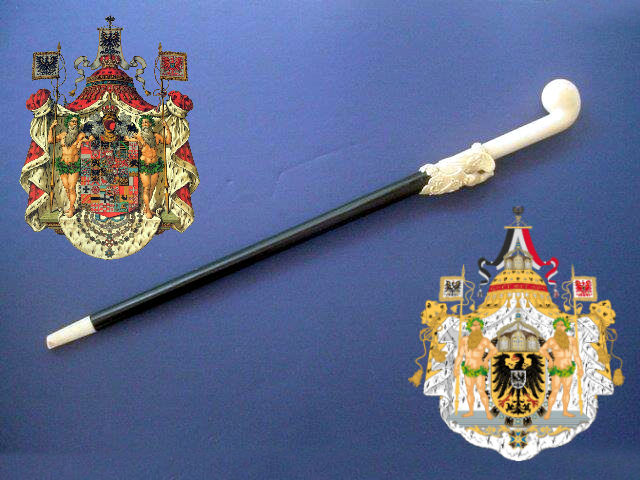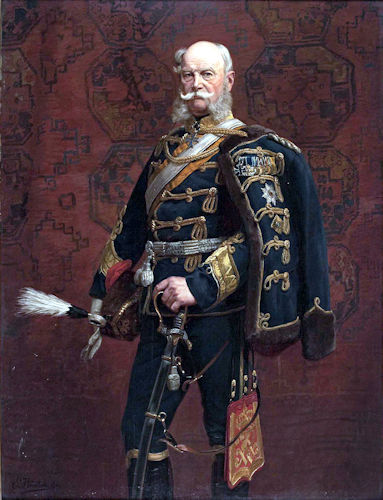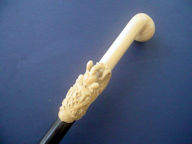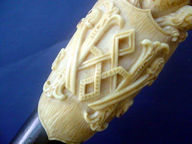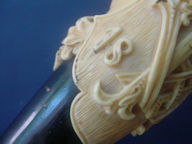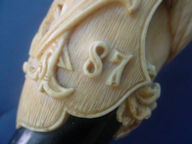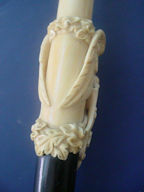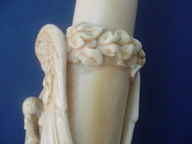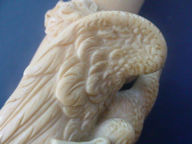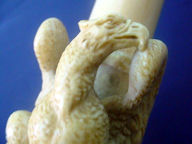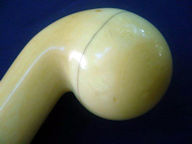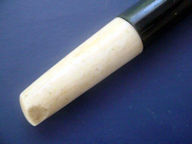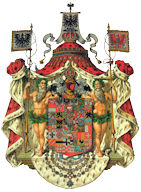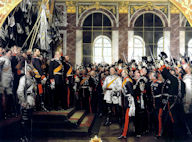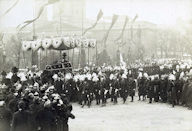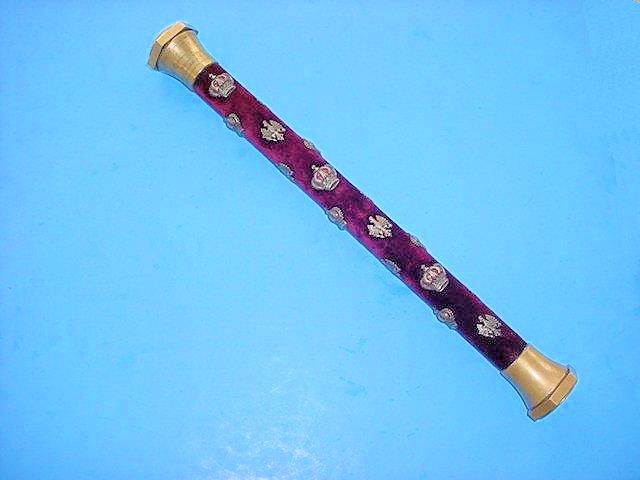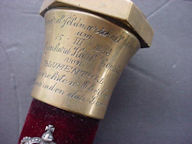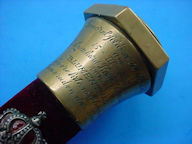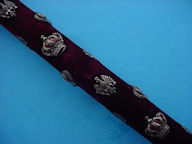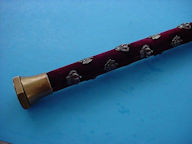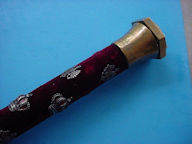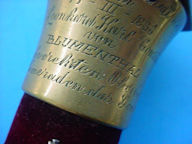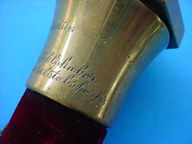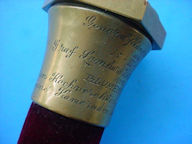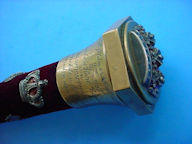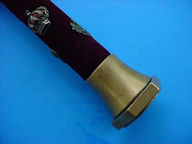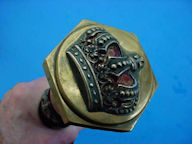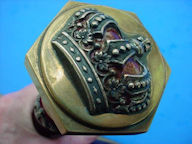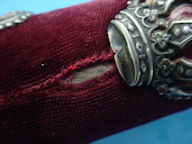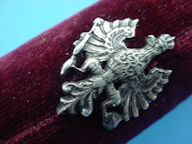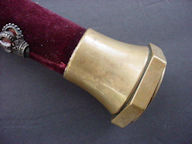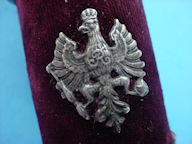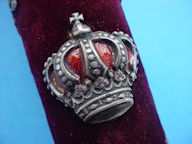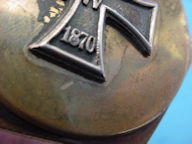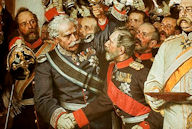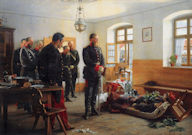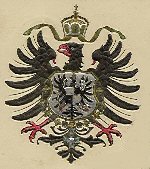|
|
|
|
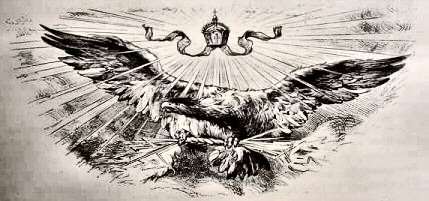

Items of Special Note
Page 1
Please be sure to visit our Kaiser Wilhelm II collection.
Also, take a look at our Frederick the Great gallery.
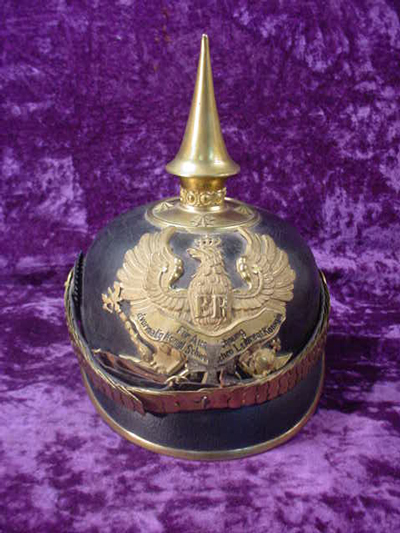 |
 |
A Pickelhaube Spiked Helmet of the 34 Infantry Regiment (Item KSPEC 1-1 & KHELMET 2-14) |
DESCRIPTION: This is one of the most rare of all the Pickelhauben we have ever had to offer, it is the Prussian Landwehr Infantry Regiment No. 34 Officers spiked helmet. This elite regiment was formed as the guard Regt. of Queen Victoria of Sweden in earlier times. The front plate consists of the Prussian Heraldic Eagle bearing a scroll upon its lower body which is inscribed ‘Fur Auszeichnung D’ Vormaligen. Königl. Schwedischen Leibregt. Königin” (In Commemoration of former service in the Kingdom of Sweden’s Queens Body Guard Regiment.) This special helmet plate was authorized on December 5th 1865 for enlisted and NCO personnel in the 33rd regt. Officers received the device from May 19, 1891 to include the 34th Infantry Regiment. The confusion comes in when we try to figure out if the 34th was an Infantry regt. or Fusilier Regt., but this helmet is designed for Landwehr because of the silver iron cross mounted in front of the plate. All we know is that they were an elite regiment in any case and the helmet is in practically immaculate condition and is considered very rare by advanced helmet collectors. The helmet has the black leather body with gilt furniture including spike, round base, star stud retainers, visor trim and flat infantry style scaled chin straps. The latter secured to the helmet body by gilt rosettes and the left side has the Prussian black and white large rosette as well. The helmet has its original carrying case but the straps and buckles are history (gone!). The silver plated Landwehr iron cross is inscribed ‘Mit Gott Fur Konig und Vaterland’ 1813. This designates the wearer as a member of the Landwehr and the translation is ‘With God for King and Fatherland”. The Landwehr term as used refers to the Royal Edict of 17 March 1813 which called up all men capable of bearing arms between the ages of 18 and 45. After 1815 this force was made an integral part of the Prussian Army, each Brigade consisting of one line and one Landwehr Regiment. The helmet is in beautiful condition with the usual leather crazing, but the lightest I have ever seen on a helmet of this age. It is only noticeable when viewing it very close up, all metal parts are perfect. The leather sweat band is in fine shape as is the inside silk head liner. No extra holds anywhere! The leather strap that sits back of the chin scales is a bit worse for wear but is there!. This is the finest and the most rare spike helmet that we have ever offered in officers Pickelhauben. And how many fine officer grade examples are available today. I would venture not many in any shape-not many at all! Here is a collector’s item extraordinaire! I am practically sure it will not be seen again except for the one or two that repose in museums. Germania scores again! PRICE: $9,550.00 NO LONGER AVAILABLE |
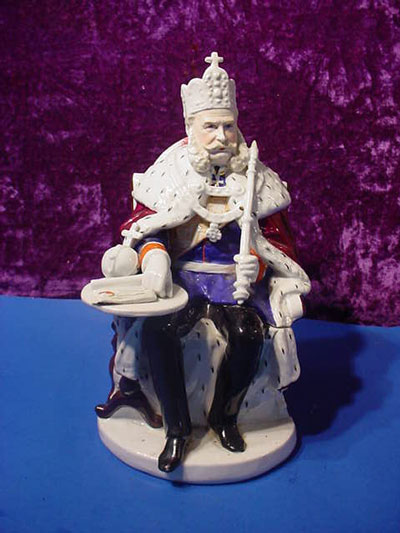 |
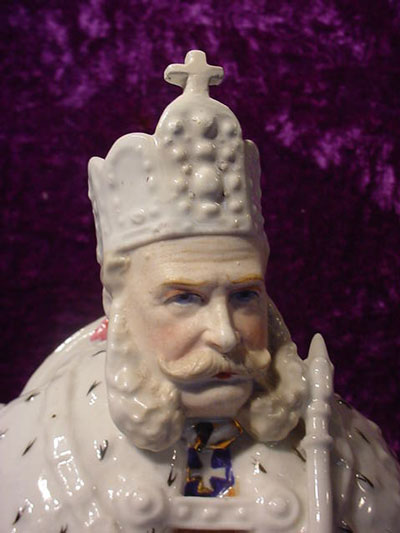 |
Kaiser Wilhelm I Tobacco Humidor (Grandfather of Kaiser Wilhelm II) (Item KSPEC 1-2 & WILHELM 9-13; Special Sales) |
DESCRIPTION: This is a magnificent likeness of Kaiser Wilhelm I, King of Prussia and Emperor of Germany, often called the Warrior King by his loving public. It was he who reigned over the union of all the Germanic states into the united German Empire. He did this at Versailles along with Bismarck, the Iron Chancellor and all of his Marshalls in attendance. He was the greatest of European royalty and was a kindly and just monarch and certainly the greatest of the Hohenzollern royal line, He is shown while seated upon the Royal Prussian throne chair. He holds the royal scepter while the orb of Empire sits upon the table beside him. Also on the table is the royal edict of unity that joined all the states of the great German confederation. The royal Prussian crown of Charlemagne rests on his head and the medals of knightly service decorate his tunic. He wears the ermine decorated cloak of the dynasty. The face of the emperor is so life like that it is remarkable in the porcelain arts. The figure comes apart in the middle to expose the compartment for the storage of tobacco; there are no markings or company names on the piece. It stands about 16 inches high and is about 6 ½ inches wide at the base by 5 ½ inches. The condition is perfect for the most part (no breaks or repairs). There is a bit of tiny scratches in the paint -- almost not noticeable at all. This is a treasure from the Grossezeit (the Great Time) of Germany’s glory and majesty. PRICE: $1,200.00 Special Sale: Reduced to $989.00 |
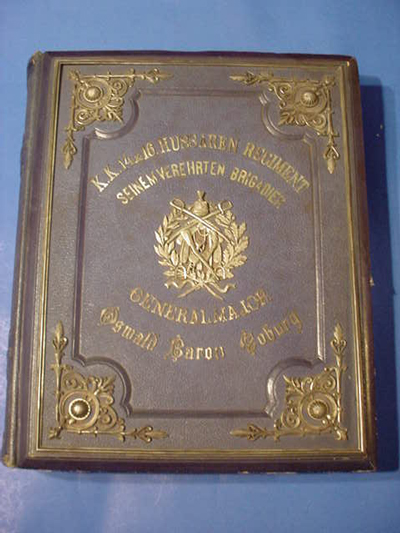 |
 |
Beautiful Presentation Album of Photos from the 14th and 16th KK Hussar Regiment of Imperial Austria (Item KSPEC 1-3 & WWI 12-10 & IMP 1-1) |
DESCRIPTION: This is a gorgeous photo album presented by the elite 14th and 16th Hussar Regiment to their Brigade Commander, Major General Baron Oswald Coburg (probably a retirement gift). In the center of the front cover is a wonderful badge style escutcheon that employs all the equipment of the horse solders (Hussars) -- carbine, swords, shako, horse stirrups, revolver, bugle, etc. and all of this is surrounded by branches of palms and another of oak leaves. This is all in the finest of 800 silver. At top and bottom are the words of presentation. The corners are highly decorated with beautiful floral designs in high relief. The cover is in lovely blue leather. The album measures 13 x 10 inches and is slightly over 2 inches deep and contains 77 mounted picture all on the studio card stock of the age; there are also two loose pictures but all the photo slots that are made to contain the images are filled. The pictures range in two sizes 2 ½ x 4 1/8th. And the bigger ones are 5 ½ x 4 ½. All are in perfect shape and the pages are clean. The Germanic phrase in the title of the albums cover KK stands for Kaiserlich and Koniglish (Imperial and Royal). This was applied to all units that served Austria and the Hapsburg monarchy. The album is in great shape throughout. The pictures of the uniformed Hussars show the dashing and daring of these soldiers of the horse. The Hussars were of course light cavalry which first originated in Hungary and of all the world's Hussars, the Austro-Hungarian riders were the best! They were very effective against the Prussians and French. The Allies in WWI and even against the Russians in the early days of WW II. This album miraculously turned up and bears silent testimony to a band of equestrian heroes who shall never be forgotten in the annals of military history and glorious renown. PRICE: SOLD |
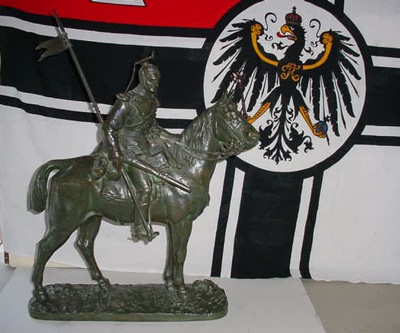 |
 |
Massive Equestrian Bronze Statue of the 5th Regiment Prussian Uhlans (Item KSPEC 1-4; BRONZEMET 2-13; BRONZE 2-9; KHISTORY 1-15; KSTATUE 5-16) |
DESCRIPTION: This is a magnificent bronze depiction of a mounted horseman of the Fifth Uhlan Regiment of the Kaisers 3rd Cavalry Division attached to the First German Army Command. They served with particular distinction in the Franco Prussian war and WW1. Uhlans were light cavalry, actually Lancers, who fought with carbines, swords, and lances. The title Uhlan was used by Lancer regiments in the Russian, Austrian and especially the Prussian armies. Uhlans typically wore a double buttoned tunic (Kurta) with a colored panel at the front, a colored sash and a square topped Lancer cap (Czapka), also spelled chapka. This cap was originally derived from a traditional design of the Polish civilian cap made more formal and stylized for military use. Their Lances usually had small swallow tail pennants known as the Lance Pennon that was found just below the spearhead (see our pictures). Prussian Uhlans distinguished themselves and fought bravely in the war against Napoleon. In WW1 the Imperial German Army included 26 Uhlan regiments. They all saw action while on duty at the first part of the war and their charge with lances struck fear in the hearts of the enemy since it has well been known that these were formidable warriors adept at warfare (up front and personal!). Later in the second year of the war the Uhlan regiments were either dismounted to serve as cavalry rifle regiments in the trenches of the western front or transferred to the eastern front where primitive conditions made it still possible for horse cavalry to play an effective role. In WWII a popular myth is that Polish cavalry armed with lances charged and were annihilated by German tanks during the 1939 campaign; this arose from the misreporting (both intentional and unintentional) of the charge at Krojanty on 1 September when two squadrons of Polish 18th Lancers armed with lances and sabers were met in combat by German cavalry led by Harry Von Johnston in what was the last charge of German cavalry with sabre. The Poles were dispersed and defeated by Germans who rode one last time in the spirit of the Old Prussian Uhlans. This is a little known fact of history that for the most part has remained hidden for all these years. The bronze statue is accurate in every detail and prodigiously dramatic in its heroic depiction. It is a huge and heavy sculpture done in the finest mode of German bronze art. It measures 26 inches high from the bottom of the base to the top of the Uhlan Czapka. The horse is 22 inches long from tail to muzzle. The base is measured at 19 ½ x 7 inches. The sculpture is signed by Leon Mignon (1847-1898), a sculptor from Brussels, Belgium. He studied under the sculptor Prosper Drion (1822–1906) at the Académie in Liège from 1857 to 1871. He was a particular admirer of the anecdotal sculpture of Léopold Harzé (1831–1893). His vocation as a sculptor of animal subjects began in Rome, where he studied on a grant from 1872 to 1876. He exhibited in Ghent (1874) and on several occasions in Paris (where he lived from 1876 to 1882) at the Salon des Artistes Français. He achieved prominence at the exposition Universelle of 1878 in Paris with his bulls fighting in the Roman countryside (Brussels, mus. a. mod.). In 1880–81, he shared a studio with the Belgian sculptor Paul DeVigne, whom he had met in Rome. Mignon’s bull tamer (liège, parc avroy) took the gold medal at the Salon of 1880. In 1882 he settled in Brussels and in 1888 produced the labors of Hercules reliefs for the stairway of the palace of Charles de Lorraine (now part of the Bibliothèque Royale Albertier). He sculpted several historical figures for the provincial law courts and was an astute philosopher of his time. In 1892 he sculpted many subjects for the Université de Liège. He excelled as a sculptor of animal subjects. Mignon occupies a leading place in Belgian realist art. He also modeled busts of Belgian personalities as well as a statuette of the Belgian painter Hubert Bellis; figurines of workers, soldiers from the Belgian regiments (c. 1889), and even an equestrian statue of a Prussian Uhlan, France’s enemy in the 1870 war; and a statue of Leopold in 1886 ( Brussels, mus. a. mod.). His works are preserved in the Musée de l’art Wallon, Liège, and the Musée d’Art Moderne, Brussels. He was completing a frieze for the Hôtel Somzée in Brussels when he died unexpectedly. He was an amazing artist and a cultured man of vision. A grand museum grade art piece personified and extraordinaire! It is priced under market value for a sculpture as fine as this one is. It is certain that one could not find any such dramatic artistic accomplishment to rival this one. Here he is! In all his Imperial glory. Listen as you view him and perhaps, just perhaps, you will hear the strains of “Heil Dir im Seigerkranz” (Hail to thee in Victors Crown.) Deutschlands Helden Lebt in ewig leben! PRICE: SOLD |
|
|
|
Pair of Candlesticks Made from Government Official’s Swords (Item KSPEC 1-5; KWEP 5-6) |
|
DESCRIPTION: Here is a unique pair of candlesticks made from actual Beamtenschwerter (official’s swords). This was the type of sword carried as a court accoutrement with the fancy uniform of a high officer of Prussian authority, or a diplomatic official. It was a tradition of sorts when a military officer retired he would find a matching sword to the one he wore for years of service and have both made into candlesticks as a memento of his time while serving Fatherland and Kaiser. We have seen examples over the years of naval swords and army models that ended up like this. Seems a shame to wreck a fine and rare weapon like this, but it obviously had great meaning to the men who served faithfully. It puts one in mind of the “swords into plowshares” proverb! Diplomatic- or government-officials’ swords of Prussia, Bavaria, and Württemberg are both beautiful and rare and two swords that would be intact of this model would bring a large premium in price. So we will just wipe a tear and offer the sword candlesticks as such. They have celluloid stock grips and the cross guards have the German-Empire eagle with the Prussian Hohenzollern crown while the pommel has the stern-looking head of the proud Prussian eagle. They are 11 ½ inches high with a base measuring across 3 ½ x 4 inches. They are quite striking in appearance and would highlight an Imperial collection and you could light up the candles some evening, fill your schnapps glass and toast the Kaiser; and possibly have beautiful, nostalgic thoughts about that better time in history. Heil, Kaiser, Dir. PRICE: $1,850.00 |
|
|
|
Savoyard Helmet (The Original Totenkopf Helmet–1600) (Item KSPEC 1-6; KWEP 5-10; KHELMET 2-17; ANTWEP 1-7) |
|
DESCRIPTION: We are proud to offer an original Savoyard helmet from the era of 1600. Head pieces of this distinctive fashion were intended for wear by the mounted Cuirassier or heavy cavalryman. They are usually referred to as “Savoyard” helmets from the tradition that large numbers of them in Les Musées d’Arte et d’Histoire in Geneva were taken as booty from the troops of Charles Emmanuel I of Savoy following their unsuccessful assault on the city of Geneva on the night of 11 December 1602. (See Claude Blair European Armous London 1958 P. 150 and Jose A Goday “Los Armets Savoyards Du Musee D’ Arte Et D’ Histoire De Geneve N.S. Vol. L 2002 PP 11-97.) The helmet was known as Todenkopf or in more modern German Totenkopf (Death’s Head). This term arises from the German denotation for skull, Saxony being a Germanic Provence. The name emanates from the terrifying appearance of this helmet with its black-hued surface and the visor in the shape of a stylized grotesque face with dark eyeholes. Being the elite troops of the early 17th century the Savoyard were the heavy cavalry. Charles Emanuel, Duke of Savoy, contributed significantly to the reputation of this Totenkopf cavalry and led to the denotation–Savoyard helmet. So it occurs that in 1602 Charles attempted to besiege the city of Geneva and commanded 2000 combatants to surround the city walls during the night of December 11. When the ring was closed at 2 o’clock the duke implemented an interesting maneuver. The 200 members of the heavy cavalry were ordered to dismount and climb the walls in their impressive armor and Totenkopf helmets using the element of surprise. The guards were to be “overmastered” (slain) in order to open the city gate for the main forces to enter; however, the alarm was raised by a night watchman and Geneva’s militia rose to meet the invaders. The attempted raid was a disastrous failure. Fifty-four Savoyards were killed and many more captured. Charles Emmanuels’ army retreated in a panic and the Savoyard prisoners were executed. Until the present day, the events of the Geneva raid and the successful defense of the city are celebrated each year at the festivities of the Escalade de Genève. Defeating the invaders, Geneva’s militia captured their plate armor which became a kind of war trophy. Some of the pieces are on view at Geneva’s Musées d’Arte et d’Histoire. Other helmets entered the art market in the course of time. Possibly, this helmet that we offer was once a trophy from this battle. On the other hand, the term “Savoyard” helmet being known as such from the events of Geneva shall not lead to the conclusion that this style helmet subsequently was not used by other heavy cavalry on the continent though it was most assuredly Germanic. The Helmet The measurements are 13 inches high from the end of the bib collar to the top comb of the headpiece. It measures 1 foot across from side to side of the collar. There is a little hook device that holds the helmet in place until it is ready to be worn. This is found just above the collar and attaches to the faceplate. This must be released also before pulling the entire mask upward to reveal the man’s face. Unique to this style of helmet are the sunshades over the eyeholes giving an even greater grotesque appearance, but this might also deflect direct sword slashes that would be directed toward the head. The collar is constructed of three layers of iron gorgets pinioned by numerous round-top rivet-looking pieces securely fastened, but giving flexibility to the wearer to move upward and downward at will. At the back there is a plume holder that would accept a colorful feather display worn at victory parades and official reviews. The helmet is in truly remarkable condition throughout and is certainly a genuine museum piece and a worthy relic of the days of knightly valor and high adventure! PRICE: SOLD |


